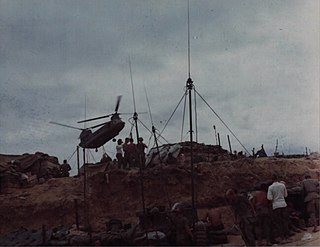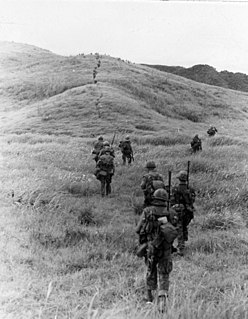
A fire support base is a temporary military encampment to provide artillery fire support to infantry operating in areas beyond the normal range of fire support from their own base camps. FSBs follow a number of plans; their shape and construction varying based on the terrain they occupy and the projected garrison. It was first created by the South Korean General Chae Myung-shin as a "Company Tactical Base" during the Vietnam War.

The Battle of Ia Drang was the first major battle between the United States Army and the People's Army of Vietnam (PAVN), also referred to as the North Vietnamese Army (NVA), and was part of the Pleiku Campaign conducted early in the Vietnam War. It comprised two main engagements, centered on two previously scouted helicopter landing zones (LZs), known as LZ X-Ray and LZ Albany. The first involved the 1st Battalion, 7th Cavalry Regiment and supporting units under the command of Lieutenant Colonel Hal Moore, and took place November 14–16, 1965 at LZ X-Ray, located at the eastern foot of the Chu Pong Massif in the central highlands of Vietnam. The second engagement involved the 2nd Battalion, 7th Cavalry Regiment plus supporting units under the command of Lieutenant Colonel Robert McDade, and took place on November 17 at LZ Albany, farther north in the Ia Drang Valley. It is notable for being the first large scale helicopter air assault and also the first use of Boeing B-52 Stratofortress strategic bombers in a tactical support role. Surrounded and under heavy fire from a numerically superior force, the American forces at LZ X-ray were able to hold off and drive back the North Vietnamese forces over three days of battle, largely through the support of both air power and heavy artillery bombardment, which the North Vietnamese lacked. LZ X-Ray was considered an American tactical victory, as the Americans claimed an almost 10:1 kill ratio. At LZ Albany, however, an American battalion was ambushed in close quarters. They were unable to use air and artillery support due to the close engagement of the North Vietnamese, and the Americans suffered an over-50% casualty rate before being extricated from the battle. Both sides, therefore, were able to claim victory in the battle.

Operation Lam Son 719 or 9th Route – Southern Laos Campaign was a limited-objective offensive campaign conducted in the southeastern portion of the Kingdom of Laos. The campaign was carried out by the armed forces of South Vietnam between 8 February and 25 March 1971, during the Vietnam War. The United States provided logistical, aerial and artillery support for the operation, but its ground forces were prohibited by law from entering Laotian territory. The objective of the campaign was the disruption of a possible future offensive by the People's Army of Vietnam (PAVN), whose logistical system within Laos was known as the Ho Chi Minh Trail.

The 1st Division of the Army of the Republic of Vietnam (ARVN)—the army of the nation state of South Vietnam that existed from 1955 to 1975—was part of the I Corps that oversaw the northernmost region of South Vietnam, the centre of Vietnam.

Firebase Berchtesgaden was a U.S. Army firebase located west of Huế overlooking the A Shau Valley in central Vietnam.
Firebase Veghel is a former U.S. Army and Army of the Republic of Vietnam (ARVN) firebase located southwest of Huế in central Vietnam.

Landing Zone Oasis is a former U.S. Army base southwest of Pleiku in central Vietnam.

Firebase Tomahawk was a U.S. Army firebase located in the Phú Lộc District southeast of Huế in central Vietnam.
Firebase Vera was a U.S. Army firebase located near the Cambodian border southwest of Pleiku in the central highlands of Vietnam.
Mai Loc Camp was a U.S. Army and Army of the Republic of Vietnam (ARVN) base located west of Quảng Trị in central Vietnam.
Firebase Mile High was a U.S. Army firebase located northwest of Kontum in the Central Highlands of Vietnam.
Landing Zone Kate is a former U.S. Army base northwest of Quang Duc Province in southern Vietnam near the Cambodian border.

Operation Lincoln was an operation conducted by the 1st Cavalry Division west of Pleiku, lasting from 25 March to 8 April 1966, with the goal of locating suspected North Vietnamese and Viet Cong bases to disrupt any planned offensives during the monsoon season.

Operation Yellowstone was an operation conducted by the 1st and 3rd Brigades, 25th Infantry Division in northeast Tây Ninh Province, lasting from 8 December 1967 to 24 February 1968.
Operation Hop Tac I was a road security operation conducted during the Vietnam War by the U.S. 9th Infantry Division along Route 4 in Dinh Tuong Province, South Vietnam from 10 February to 10 March 1968.
Phase III of the Tet offensive of 1968 was launched by the People's Army of Vietnam (PAVN) and Viet Cong (VC) from 17 August to 27 September 1968. The offensive was divided into two waves of attacks from 17 to 31 August 1968 and from 11 to 27 September of that same year.
Operation Scotland II was a U.S. Marine Corps security operation that took place in northwest Quảng Trị Province from 15 April 1968 to 28 February 1969.

Operation Pickens Forest was a U.S. Marine Corps operation in Quảng Nam Province, South Vietnam that took place from 16 July to 24 August 1970.

Operation Imperial Lake was a U.S. Marine Corps, Republic of Korea Marine Corps and U.S. Army operation in the Quế Sơn District, Quảng Nam Province, South Vietnam that took place from 1 September 1970, to 7 May 1971. It was the last operation of the 1st Marine Division during the Vietnam War.
Operation MacArthur was a United States Army military operation in the Central Highlands of South Vietnam from 12 October 1967 to 31 January 1969. The early phases of the operation encompassed the Battle of Dak To from 3 to 23 November 1967.










